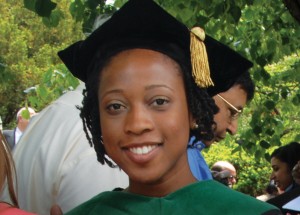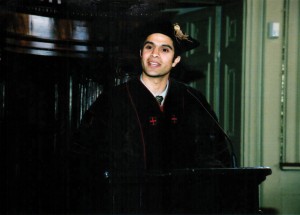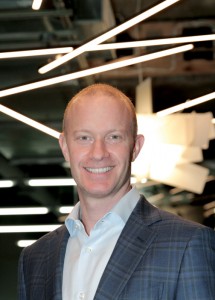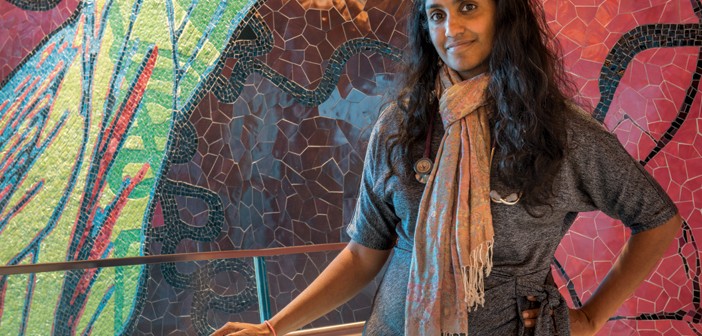How are our young alumni faring in their careers?
At Alpert Medical School, the annual Ceremony of Commitment to Medicine, where students receive their first white coat, concludes with a class photo. The students smile up at the camera, all clad in their pristine, short coats. Though each has a different reason for being there, though each might wonder if she or he really belongs there, for that one moment in time they are united in their excitement, and in the promise and uncertainty of what the future holds.
Speaking to a diverse group of alumni who graduated 15 years ago or less, a new picture takes shape, one that is more heterogenic, less shiny. No longer are all of these MDs wearing white coats. Now they are united by their commitment to push the boundaries of medicine—against the scope of traditional care, the constraints of the health care system, and even the expectations of their profession. But the lessons learned as medical students have stayed with them and shaped them, not just as doctors but as people.
A Hero Profession
“I didn’t think I could step into a hospital again,” Jyothi Marbin ’96 MD’06 says. It was 1995, her senior year at Brown, and she was 21 years old. Her father had amyotrophic lateral sclerosis, or Lou Gehrig’s disease, and he had just told her that he wanted to be taken off his ventilator.
ALS, a neurodegenerative disorder, slowly wears down a person’s ability to live a normal life—to eat and move and breathe and sleep—and Marbin grew up taking care of her father. “We fed him, helped him get dressed, gave him a shave, and turned the pages of his newspaper,” she says. Her high school years had many nights in, and she spent weekends during college at home. Giving her father a normal life meant giving up a normal adolescence. “I think I expected to feel happy that his suffering was over, but instead I realized I needed to grieve,” she says of his death. It would be another five years before she returned to Brown to begin her medical education.
Marbin grew up in Brookline, MA, and her father was an incredible force and presence during her childhood. “He ran our household from his wheelchair,” she says. Her parents were originally from India, and her mother became a physician before she left for the US; doing so was uncommon in a culture where women were expected to focus on raising a family. And for that, she was an inspiration to her daughter. “My mom was a doctor, and I wanted to be just like her,” Marbin says.
“If you were proud of your parents, then the natural choice was to do what they did,” says Amit Joshi ’97 MD’01, a general surgeon at Einstein Healthcare Network in Philadelphia. “And I was always proud of my parents.” Both his mother and father were physicians, and medicine was infused in his childhood. “As early as I can remember, I wanted to become a doctor,” he says. Joshi felt no pressure from his parents to pursue medicine, but he never changed his mind about his path, applying early to Brown and the Program in Liberal Medical Education.
Joshi’s wife, Nikki Ariaratnam ’00 MD’04, was shaped by her parents’ experiences in much the same way. Ariaratnam, a radiologist, is the only child of two physicians—her mother a psychiatrist, and her father a radiation oncologist. “You saw what you loved in your parents,” she says. “They cared for people and that was their job. I couldn’t think of anything better than that.”
As Joshi put it, “Our parents were in hero professions.”
Early Lessons
Marbin’s father’s death left her an orphan; her mother had died eight years earlier. On a cold, snowy day in Boston on March 4, 1988, her mother was walking home after dropping her car off at the gas station. “When she arrived at the front door, she was gasping for breath,” Marbin says, and she collapsed in the doorway. “She never woke up after that.” Her mother had suffered a fatal asthma attack. “After losing her, I was so sure I wanted to be a doctor,” Marbin says, and her father pushed her along that path. “I understand now why he wanted this for me,” she says. “He wasn’t sure how long he would be there.”
Ariaratnam, too, grappled with a parent’s illness from an early age. When she was 13, her mother was diagnosed with ovarian cancer.
That year, clinicians were piloting a new radiological test for cancer, the PET scan. The uncontrolled growth of tumor cells leaves behind trails in the body where there is excessive glucose intake, and the PET scan flags the trails with a radioactive marker. When clinicians combine the PET scan findings with a traditional anatomic CT scan, they can easily follow the trails to the sources of cancer in the body.
Ariaratnam’s father came across the then-experimental treatment by chance while reading a radiology journal, and without hesitation he flew his wife to Kentucky to receive the treatment. It proved to be a pivotal decision—one that gave her seven more years of health despite a diagnosis with a five-year survival window.
“That was the first time I realized how radiology can save lives,” Ariaratnam says. As part of her day-to-day life now, she consults the same PET scans that saved her mother, along with lifesaving breast imaging techniques that can detect cancers in the body long before they become fatal.
In 2007, Ariaratnam’s mother died at Memorial Sloan Kettering Cancer Center in New York, blocks away from where Ariaratnam and Joshi were completing their residencies at Weill-Cornell NewYork-Presbyterian Hospital. After her mother’s death, it was important to Ariaratnam to remember her experience on the other side of patient care. “A physician needs to understand fear and doubt,” she says. “When I give my patients bad news, I feel connected to them because I’ve been through it with my own mother.”
Small Good
Elizabeth Niemiec MD ’10 didn’t always know she would be a doctor. Medicine came into her life later, as a way to turn scientific rigor and service into meaningful good with patients. Niemiec, a psychiatrist, lives and practices in Newport, RI, and originally pursued ophthalmology. She poured her energy into the field as a student, and even published research in the journal Ophthalmology. But when Match Day arrived, Niemiec did not match with any of her preferred programs. “It was a huge blow,” she says, and it forced her to reconsider what she truly wanted to do as a physician.
“I wanted to see someone now, and see someone later, and see how I have helped them or not,” she says. And that, she later realized, was a luxury psychiatry afforded. “The primary way we figure out what’s wrong with a patient is by talking,” she says. Psychiatry is a slow science, and it may take weeks for a patient to begin responding to treatment. But even though it can take time, Niemiec derives satisfaction from the process of helping patients recover.
Dermatologist Antonio Cruz MD’06, meanwhile, loves the immediacy of his work. Cruz has his own private practice, SKINPros, in Providence and specializes in performing Mohs micrographic surgery, which is widely accepted as the most effective technique for removing the most common skin cancers. “We’re lucky in our field,” Cruz says. “People can come in with cancer and leave without it.”
Cruz grew up in Cumberland, RI, and as a boy fixed boilers with his father. Many of his patients knew him back then, and Cruz relishes being close to his roots as a physician. His patients are also his neighbors. “My patients know of me and my family,” he says. “We drive the same roads.”
For Niemiec, medicine doesn’t need to be anything grandiose. “My mission is pretty small,” she says. “I want to be a good psychiatrist, and I know I can make a difference in lives one at a time.”
A Culture of Health
Growing up in San Francisco, Kara Chew ’01 MD’05 saw the forgotten faces of her community volunteering in soup kitchens and with the homeless. As a physician, she cherishes what she learned from their experiences. “Medicine is much more than treating a condition; it’s about advocating for patients in the face of immense barriers,” she says.
Chew, a physician-scientist at the David Geffen School of Medicine, UCLA, researches the ways hepatitis C affects cardiovascular risk in HIV-positive patients. But she still spends considerable time on patient care, seeing patients at a community HIV clinic and educating fellows in the infectious disease track at UCLA.
Early in her training she knew she would not be confined by the walls of a laboratory or a hospital, and as a student Chew began working with the prison populations of Rhode Island. At the time, very few prisons were treating or screening for hepatitis C in inmates despite the serious need; in Rhode Island alone around 17 percent of inmates are infected, according to a 2014 study in the Journal of Urban Health. Chew’s work in Rhode Island’s prisons rekindled a passion for primary care that solidified the kind of physician she wanted to be. “When I was younger I didn’t feel like I had much time to make a real difference,” Chew says. But now her work brings her into the same spaces as the shelters she grew up serving.
Primary care physicians often find themselves at a confounding intersection of medicine, where long-standing social inequalities and lack of access to care create barriers for both patients and physicians. But specialists are no strangers to the challenges of serving patients at the margins. Often patients will come to them in the late stages of disease, when earlier intervention would have led to better outcome.
The Grind

Akita Evans
Akita Evans, MPH MD ’07, who came to Brown via the Early Identification Program with Tougaloo College, a historically black college in Mississippi, is a family practitioner. She began her career in community health centers right around the time that funding for such centers was beginning to dwindle. “We provided great care with minimal resources,” she says. Evans continued her work in community health centers at Oakhurst Medical Center in Stone Mountain, GA, and no matter where she went money was an issue for her patients. One visit could be the first and last chance she had to make an impact. “I would send my patients off with a hope and prayer because I didn’t know if they could afford to come back,” she says.
There can be an inevitable grind that defines specialties like family medicine. “As a primary care physician, you can do it all,” John Luo ’09 MD’13 says. The opportunity to use knowledge that spans specialties drew him to the field, but the same breadth of care eventually took its toll. “The toughest moments were feeling like I couldn’t make a difference,” Luo says. “Seeing physicians and patients suffer was awful, and to not have a solution for somebody was very difficult for me.”
Physicians in primary care suffer some of the highest rates of burnout in medicine, a problem that spans the profession. “It doesn’t take much to tip over,” Evans says, and last year, she decided to take a position at a practice focused on functional medicine. “You can’t meet every need in one day,” she says. “I could have stayed, but at my own cost.” Evans is now hoping to address the root causes of disease at ANWAN Wellness Medical Center, near Atlanta, an integrative medicine clinic that focuses on lifestyle changes and preventive care. Even in the face of daunting social problems, she says, “people can still be better stewards of their health.”
Faced with the same grind of primary care, Luo decided that he didn’t want to continue on to residency. Instead he launched his own company, Doctor’s Choice, which focuses on creating transparency and patient education around health insurance. The perspective he got while training in medicine was invaluable for learning how to spearhead change, he says: “I was always able to see inefficiencies when I was a student, and I always asked myself, how could I make it better?”
Root Causes
For Giridhar Mallya ’99 MD ’03, the answer to that same question lies in transforming social policies. “I want communities to demand more of their decision-makers,” he says. Mallya is a senior policy officer at the Robert Wood Johnson Foundation, and before that honed his expertise at the Philadelphia Department of Public Health. Dedicated to finding ways to mend invisible tears in a patient’s social web that create poor health and disease, he has tackled issues from tobacco control to childhood obesity.

Giridhar Mallya
And like Evans and Luo, Mallya’s first encounters with these issues came from his training in family medicine. Witnessing patients suffer from preventable problems was a watershed moment in his career. “It was really eye opening,” he says. “Without their health, people have much less ability to serve their families and communities.”
Jyothi Marbin’s approach takes something of a middle ground. “I want people to realize their potential to give,” she says. Marbin hopes to empower young physicians to engage with their communities and provide innovative care as director of the Pediatrics Leadership for the Underserved (PLUS) residency program at the University of California, San Francisco School of Medicine. The 11-year-old program, of which she is an alum, trains pediatricians to lead the transformation of health systems for underserved children.
“You can’t practice medicine in a silo,” Marbin says. She spent the five years after her college graduation at City Year, an AmeriCorps program dedicated to transforming education in poor communities. And at Brown she aimed to foster the same kind of change. As a medical student she helped to create the Rhode Island Medical Legal Partnership, which connects patients with the legal help they need to resolve issues beyond the scope of a doctor’s care: the presence of mold in a rental unit that causes asthma flare-ups, or an electricity shutoff in the household of a young mother. To instill the same innovative thinking in pediatrics residents, Marbin is working on plans to scale the PLUS program across other hospitals.
“Our problem is bigger than the solution we have,” she says, but she remains hopeful. “The power of medicine relies on whether physicians actually try to change things.”
Search for Meaning
In a sharp gray suit and Chelsea boots, Jason Slosberg MD’01 has the easy manner of success. Slosberg, 44, is the CEO of Linkbee, a technology startup, but he comes from humble roots. He grew up in a blue-collar town in Suffolk County, Long Island, where most kids pursued vocational studies. He became the first in his family to go to college, and by the time he arrived at Brandeis University, he was hungry for something different. After graduation his mother and father moved to opposite ends of the country. He knew he couldn’t go home again, and did not have a clear plan for his career. “I was quite lost,” he says. “I had drive, but no direction.”

Jason Slosberg is CEO of Linkbee, a startup that creates smart-home technology.
After a chance encounter in Boston, Slosberg joined and eventually led the development of a small computer business, beginning work that would become his life’s calling: turning around failing businesses. Slosberg went on to lead a company focused on architectural skylights. But as much as he loved the work, he began to feel unsatisfied. Slosberg craved a career that could have a meaningful impact on others. A friend suggested that he check out the postbaccalaureate program at Columbia University, and the next day, on a whim, he was submitting an application.
He had never taken a science class during college. “When I stepped foot in Columbia, I knew that this was the right path,” he says. After finishing his postbac, Slosberg was among the few students admitted to Brown Medical School through its linkage with Columbia.
The Crystal Ball
There is a tradition in the second year of medical school at Brown called the crystal ball, where students predict the specialties their classmates will end up in. When it came time for his classmates to write their guesses for him, Brad Weinberg ’03 MD’11 was overwhelmingly a fill-in-the-blank for business. “I am medically trained but not a practicing physician—that’s my complicated relationship with clinical medicine,” he says.
After founding and leading his first venture-backed company while still a medical student, Weinberg went on to start Blueprint Health in 2011, and he is still the managing partner. The New York-based startup accelerator offers mentorship and funding for entrepreneurs in the early stages of launching health care-focused businesses. Even though Weinberg is now fully dedicated to his career path, he says he wouldn’t be where he is if he hadn’t gone through medical school.
Weinberg loved his clinical rotations, and still remembers patients from years ago. “It’s those moments when you really touched someone that were special,” he says. But he envisioned creating something bigger than what he alone could accomplish with patient care. In his third year of medical school, Weinberg launched his first company, ShapeUp, with his classmate Rajiv Kumar ’05 MD’11.
“There is so much about medicine that I love,” Weinberg says. “But there is something so amazing to see the impact we can have on thousands of people a year.” In his fourth year of medical school, he decided to go all in with ShapeUp. “And in that moment, I was saying goodbye to medicine.”
Taking the Leap
During the early years of medical school, Slosberg longed for more patient contact, and the clinical years more than made up for it. He fell in love with surgery, as did one of his best friends, Amit Joshi, and for a while he was intent on doing plastic surgery. “He has an inquisitive mind and an eye for imperfections,” Joshi says. “And Jason knew how to perfect them.”
When it came time to choose a residency, Slosberg felt a familiar unease. “I had to come to terms with picking something I would do for the rest of my life,” he says. “It was scarier for me to feel locked in than to take a leap into the darkness.” So he leaped.
That year, Slosberg got a call from his brother. He had just taken over a distribution company specializing in disposable goods, and wanted Jason to join him in running it. Slosberg said yes, and after graduating in 2001, he, too, said goodbye to medicine. For years, he was torn about the decision, and when he explained his medical background to his new coworkers, many of them were incredulous. “They would ask me what I was doing here and my heart would sink,” he says.
But it was ultimately the right decision. Since graduating from the Medical School, Slosberg has seen the turnaround of the company he joined with his brother, and cofounded another company, Legacy Converting, that was recognized by the state of New Jersey for its outstanding work culture. But with Linkbee, Slosberg is pivoting back toward his roots in medicine. Linkbee, he says, will connect household devices to an “Internet of things,” where common objects can absorb and learn from a web of data detailing how people live: a light bulb automatically lights a path when you are up in the middle of the night, for example.
“Being a doctor is still a part of my DNA,” Slosberg says, and for him the Internet of things is like the human body. “It’s a way of bringing together disconnected parts like a biological system.” Linkbee is in its infancy, but Slosberg has broad ambitions. “We are on the precipice of an era where technology will allow inanimate systems to act like biological entities,” he says. “I have a vision and belief that it can be done.”
Helping and Healing
Wherever their paths have taken them, these young doctors live by values solidified by their education at Brown’s Medical School. From transforming policy to launching businesses to caring for patients, alumni are serving their communities and changing the way people live. “It’s simple. Physicians heal—whether that’s a person, a system, or a problem,” John Luo says. “Being a physician is a frame of mind. It is never going to change.”
Brad Weinberg adds, “I see so much of what I do now to help founders in the same way as when I would help my patients.”
When the workday is done, alums change lives at home, too. This February marks two years since Jyothi Marbin took in her foster son. “We had the opportunity to help a wonderful young man who didn’t have a home,” she says. “We talk all the time about how important it is to serve our community, and this is how we brought that difference into our family.”
For these MDs, medicine is all about making positive changes—large or small—a reality for everyone. “People ask me if I miss being a physician,” Giridhar Mallya says, “and I tell them I can now be a physician to a community.”




